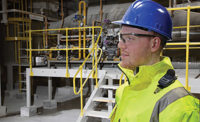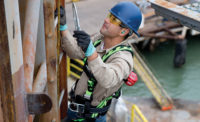Twenty-two million workers are exposed to hazardous occupational noise each year.1 Prolonged exposure to excessive noise levels can cause life-changing damage because the harm to the sensory cells and other structures within the ears is irreversible, resulting in permanent noise-induced hearing loss (NIHL).
NIHL is more common than diabetes or cancer.2 It results in injuries that can seriously impair a worker’s quality of life. Employers, meanwhile, run the risk of reduced productivity, rising costs due to sickness days, increased costs for training and recruitment and catastrophic penalties and compensation claims. OSHA estimates that employers spend $242 million annually on workers’ compensation for hearing loss disability.3
Understanding legal requirements
To keep workers safe, the OSHA sets the legal limits on noise exposure in the workplace based on a worker’s time-weighted average over an eight-hour day. OSHA’s maximum permissible exposure limit to noise is 90 dBA (decibels) for all workers. When workers are exposed to an average noise level of 85 dBA or higher for an eight-hour shift, employers must implement a hearing conservation program.
These programs require employers to measure noise levels, provide free annual hearing exams and hearing protection, offer training, and conduct evaluations of the adequacy of the hearing protectors in use. The programs cost around $350 per worker each year,4 necessitating $70,000 annually for a 200-strong workforce. They are mandatory until the employer makes sufficient changes to the tools, equipment and schedules used so that conditions are improved, and worker exposure is demonstrated to be less than the 85 dBA.
Conversely, the National Institute for Occupational Safety and Health (NIOSH) recommends that all worker exposure to noise should be controlled below or equivalent to the level 85 dBA for eight hours, a decibel level comparable to the sound of a passing diesel truck. NIOSH designed its recommendations to represent the best scientific practice concerning noise exposure. On the other hand, the OSHA exposure limit is the minimum legal requirement that must be complied with.
Using noise monitoring to gather accurate insights
Noise monitoring provides accurate insights into the noise levels of a working environment so that businesses can identify problem areas and ensure they adhere to OSHA regulations. However, professionals undertaking the monitoring should be trained and prepared sufficiently with the right equipment as minor errors in noise level estimates can lead to major errors in exposure calculations. Inaccurate estimates can risk employee health, employer prosecution and unnecessary expenses undertaking exposure limiting measures based on inaccurate data.
Two pieces of equipment essential for the assessment are the sound level meter, primarily designed as a hand-held device used by an operator, and the noise dosimeter, which a staff member wears for their working shift. A sound level meter is an ideal solution for measuring the overall noise level of a task, piece of machinery or area. On the other hand, dosimeters are best for personal noise measurements where it is difficult or unsafe to get close to employees with a sound-level meter because dosimeters are smaller and body-mounted. For example, a dosimeter would be ideal for forklift truck drivers exposed to many different noise levels and irregular working patterns.
If an assessment establishes that noise levels pose a risk to workers, personal hearing protection should be supplied immediately while other more permanent solutions are executed. However, personal hearing protection should only be considered the primary solution when all other options have been exhausted, such as physically separating staff from the noisiest areas or rotating shifts to spread individual exposure.
A noise survey will determine which employees need personal hearing protection, based on whether:
- The employee is exposed to workplace noise during an 8-hour work shift, in which the noise averages 85 dBA (50% dose) or greater
- An employee has not yet had a baseline audiogram established in a work environment averaging 85 dBA or greater
- An employee has experienced a standard threshold shift
Occupational standards specify a maximum allowable daily noise dose, expressed in percentages. For example, a person exposed to 85 dBA per NIOSH REL or 90 dBA per OSHA PEL over an 8-hour work shift will reach 100% of their daily noise dose. The noise dose is based on the sound exposure level and duration, so for each increase of 3-dB (NIOSH) or 5-dB (OSHA) in noise levels, the duration of the exposure should be cut in half.
Selecting personal hearing protection
When selecting hearing protection equipment, employers should consider the relationship between hearing protection and other personal protective equipment (PPE). For example, an employee wearing prescription or safety glasses will not obtain an adequate fit from a standard ear muff, so plugs or semi-inserts may be more suitable. In working environments where hard hats are worn regularly, a hard hat with built-in hearing defenders should be considered.
Employers must also understand the process of reducing sound, known as attenuation. If a protector with too little attenuation is used then employees will not receive enough protection.
However, too much noise reduction can create feelings of isolation, and an employee may need to remove their PPE to communicate. In addition, over-attenuation can cut out safety warnings such as fire alarms or sirens from reversing vehicles, resulting in further risks to workers. As a general rule of thumb, businesses can avoid over-protecting workers by ensuring the level of exposure is not reduced to a level below 75dB(A).
A business’s unique working environment also impacts the best protector choice. For example, hot humid conditions can make earmuffs uncomfortable to wear, while dusty environments can cause hygiene problems. In dusty workplaces, it is crucial to keep the hands clean when inserting protective plugs to avoid ear infections. It is also advisable to ascertain any history of ear problems such as irritation or earache from employees, as earmuffs that fit over the outer ear may be preferable to avoid medical complications.
Removing PPE, even for short periods, has a significant effect on exposure. Therefore, it is crucial that hearing protection is comfortable. Providing employees with a choice of protection will encourage all-day wear and, ultimately, support their safety.
Keeping your future workforce safe
Employers have a responsibility to prevent damage to their workers’ health, however skill and knowledge of measuring noise can take years to build, so the information above can only be considered a foundational introduction. If certain aspects of noise monitoring, protection and control are outside of an individual’s competencies then external consultancies, training and support can be sought to bridge knowledge gaps and ensure employees get the critical protection they need.
References
- https://hearingimprovementcenter.com/hearing-healthcare-news/cdc-finds-hearing-loss-is-third-most-common-chronic-condition
- https://hearingimprovementcenter.com/hearing-healthcare-news/cdc-finds-hearing-loss-is-third-most-common-chronic-condition
- https://www.starkey.com/blog/articles/2019/03/Exposure-to-too-much-noise
- https://pubmed.ncbi.nlm.nih.gov/29251690/#:~:text=Hearing%20conservation%20programs%20(HCPs)%20mandated,about%20%24350%2Fworker%2Fyea



